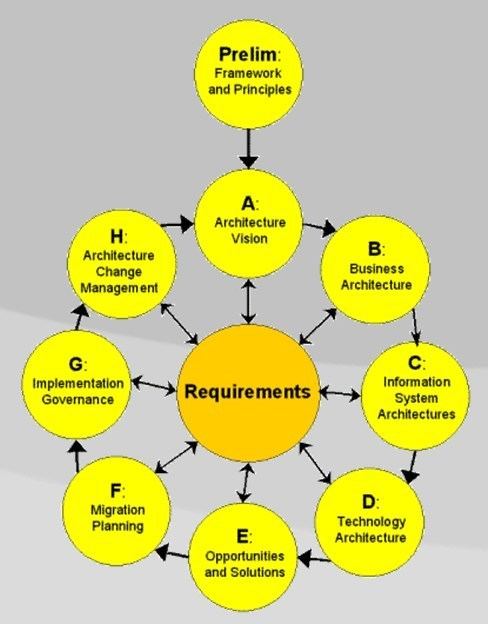 | ||
The Open Group Architecture Framework (TOGAF) is a framework for enterprise architecture that provides an approach for designing, planning, implementing, and governing an enterprise information technology architecture. TOGAF is a high level approach to design. It is typically modeled at four levels: Business, Application, Data, and Technology. It relies heavily on modularization, standardization, and already existing, proven technologies and products.
Contents
- Overview
- Enterprise architecture domains
- Architecture Development Method
- Enterprise Continuum
- TOGAF Certified Tools
- Qualifications
- Foundation
- Certified
- History
- Criticism
- References
TOGAF has been developed starting 1995 by The Open Group, based on DoD's TAFIM. As of 2016, The Open Group reports that TOGAF is employed by 80% of Global 50 companies and 60% of Fortune 500 companies.
Overview
An architecture framework is a set of tools which can be used for developing a broad range of different architectures. It should:
The ANSI/IEEE Standard 1471-2000 specification of architecture (of software-intensive systems) may be stated as: "the fundamental organization of a system, embodied in its components, their relationships to each other and the environment, and the principles governing its design and evolution."
However TOGAF has its own view, which may be specified as either a "formal description of a system, or a detailed plan of the system at component level to guide its implementation", or as "the structure of components, their interrelationships, and the principles and guidelines governing their design and evolution over time."
The Architecture Development Method (ADM) is core of TOGAF which describes a method for developing and managing the lifecycle of enterprise architecture.
Enterprise architecture domains
TOGAF is based on four interrelated areas of specialization called architecture domains:
Architecture Development Method
The Architecture Development Method (ADM) is applied to develop an enterprise architecture which will meet the business and information technology needs of an organization. It may be tailored to the organization's needs and is then employed to manage the execution of architecture planning activities.
The process is iterative and cyclic. Each step checks with Requirements. Phase C involves some combination of both Data Architecture and Applications Architecture. Additional clarity can be added between steps B and C in order to provide a complete information architecture.
Performance engineering working practices are applied to the Requirements phase, and to the Business Architecture, Information System Architecture, and Technology architecture phases. Within Information System Architecture, it is applied to both the Data Architecture and Application Architecture.
Enterprise Continuum
The Enterprise Continuum is a way of classifying solutions and architectures on a continuum that ranges from generic foundation architectures through to tailored organization-specific both within and outside the Architecture Repository. These include architectural models, architectural patterns, architecture descriptions, and other artifacts. These artifacts may exist within the enterprise and also in the IT industry at large.
The Enterprise Continuum consists of both the Architecture Continuum and the Solutions Continuum. The Architecture Continuum specifies the structuring of reusable architecture assets and includes rules, representations, and relationships of the information system(s) available to the enterprise. The Solutions Continuum describes the implementation of the Architecture Continuum by defining reusable solutions building blocks.
TOGAF Certified Tools
The Open Group has a certification program for TOGAF 9 Tools. For the latest register of certified tools see The Open Group register.
Qualifications
The Open Group oversees formal qualifications in TOGAF at two levels, which can be taken following formal training or self-study.
Foundation
(Level I) Ensures that an individual understands Enterprise Architecture along with core concepts and terminology of TOGAF.
Certified
(Level II) Further to the Foundation qualification, this establishes that the candidate is able to analyse and apply their knowledge to business problems.
Gaining TOGAF Certified status automatically confers free membership of the Association of Enterprise Architects.
History
TOGAF was initiated in the early 1990s as methodology for the development of technical architecture, and has been developed by The Open Group into an extensive enterprise architecture framework. In 1995, the first version of TOGAF (TOGAF 1.0) was presented. This version was mainly based on the Technical Architecture Framework for Information Management (TAFIM), developed since the late 1980s by the US Department of Defense
In December 2001 TOGAF 7, the "Technical Edition", was published. TOGAF 8 ("Enterprise Edition") was first published in December 2002 and republished in updated form as TOGAF 8.1 in December 2003. Around 2005 TOGAFTM became a registered trademark of The Open Group. In November 2006 the Open Group released TOGAF 8.1.1. According to The Open Group, as of February 2011, over 15,000 individuals are TOGAF Certified. As of September 2012 the official register has over 20,000 certified individuals.
An evolutionary development from TOGAF 8, TOGAF 9 includes many new features including:
Additional guidelines and techniques include:
The latest version is TOGAF 9.1, launched on 1 December 2011.
The Open Group provides TOGAF free of charge to organizations for their own internal noncommercial purposes.
Criticism
Despite TOGAF being considered as the de facto standard in an EA practice, it is not without its critics:
